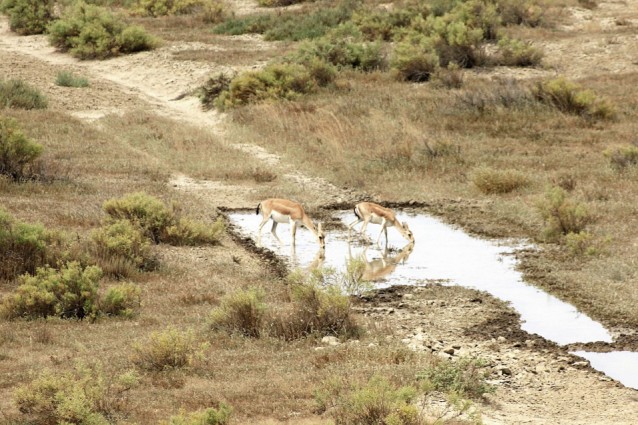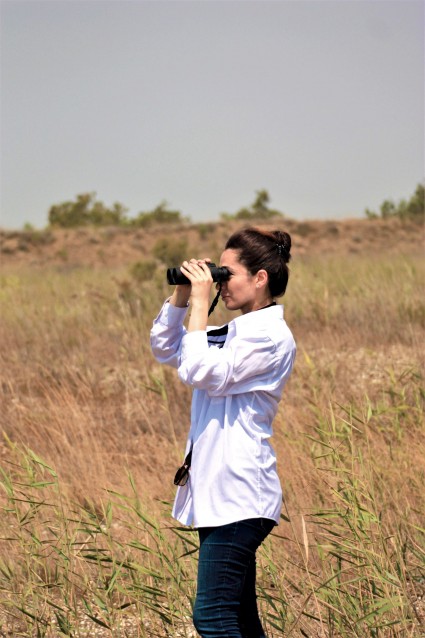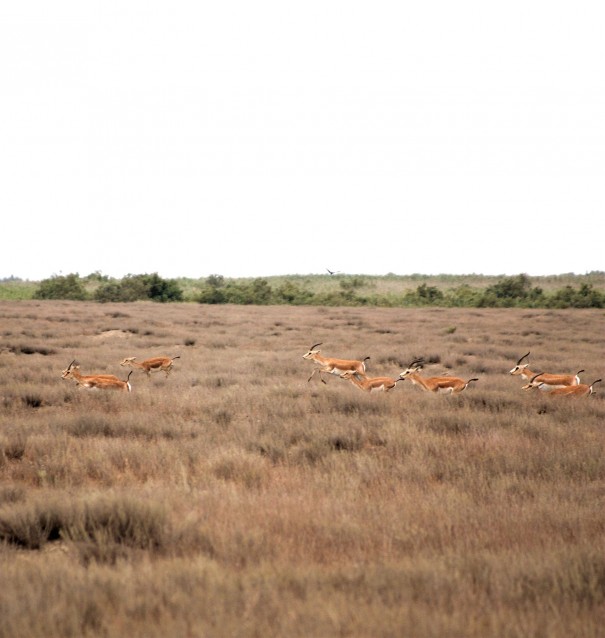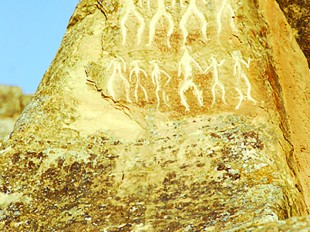Look, there’s one crossing the road! I popped my head up so quickly that I almost dropped my camera’s zoom lens which I had been fumbling to put on as we bounced down a dusty service road in the Shirvan National Park. About 40 metres ahead of us the brown and white figure of a ceyran (pronounced jay-rahn) sprang briefly into view before vanishing into the brush.
Mark down one male, crossing from the left side to the right, Sevinj Sarukhanova instructed. She was the biologist leading our group on a survey of the park’s goitered gazelle population. Next to her in the back seat of our jeep, Seymur Kerimov, who works at the park, made a note on his clipboard. Up front, our driver and I monitored the steppe ahead for signs of more ceyran. As we came over a slight rise in the road, we saw a herd of several dozen grazing on the desert shrubs.
Vay, çox gözəl! Sevinj raised her binoculars to begin counting. Upon seeing these magnificent animals prancing gracefully about, my inner linguist wondered if there was any connection between the English word gazelle and the Azerbaijani word “gözəl,” meaning beautiful. In Azerbaijan, the gazelle itself is actually closely associated with the concept of beauty. The local word, ceyran, is a common girls’ name, and women are often flattered by the admiring men in their life by being told that they have eyes like a gazelle.
Sevinj herself fell in love with the gazelles a few years ago, a love which was born out of her life-long passion for nature. Though she grew up in Baku, her family’s roots are firmly tied to the Qusar region with its magnificent mountains and forests. She spent her summers and free time around schooling there with her grandparents enjoying the beautiful countryside. As she grew up, she studied at university, initially thinking she would become a physician. When the opportunity arose, however, to get back out into nature, the happy memories of her childhood beckoned her, and she chose the path of biology instead. She found herself working with the Azerbaijan branch of the World Wildlife Fund (WWF) and the German Society for International Cooperation (GIZ), where she became increasingly involved in conservation and environmental education programs. Eventually, she became a project officer for the WWF’s Gazelle Restoration Project.
|
Azerbaijan's goitered gazelle population was devastated by hunting in the early half of the 20th century. Their population went from tens of thousands to only 200 in the 1960s. But now the Shirvan National park alone has over 6,000 animals, with hundreds more being reintroduced to other parts of the country.
|
During this work, she became involved in capturing gazelles for relocation and tagging them with radio collars. There was one time when we were releasing gazelles for relocation, we had one gazelle that had been in her box for a long time, and she couldn’t get up. We spent an hour massaging her, but she still wouldn’t get up. We ended up taking her to the ranger house and cared for her there overnight and then were able to release her in the morning... [Doing this kind of work] was the first time I saw these animals up close, and that’s when I realized how much I like them...
In 2017 Sevinj received a DAAD scholarship and did PhD research on the gazelles’ habitat and distribution at the Conservation Biogeography Lab at Humboldt University in Berlin. She recently entered a PhD program at Baku State University and is continuing her studies of the gazelles. They are an endangered species that, as she says, have a lot of questions open. For example, no one knows for sure how they are related to the other gazelle populations around the world. Efforts are being carried out to do a genetic analysis using DNA from fecal samples (this method is preferred over tissue samples because it’s less invasive and causes less stress to the animals.) Azerbaijani gazelles also have a unique ability that many other gazelles don’t possess: when needed, they can drink salt water from the Caspian Sea to survive. Gazelles from other populations would not be able to endure under such circumstances. Sevinj hopes that her research will uncover more about Azerbaijan’s ceyran population and bolster conservation efforts on their behalf.
Locusts bounced off our windshield like ping-pong balls as we crawled our way through the park looking for more gazelles. In total, we covered 98 kilometres of service roads in about five and a half hours and documented several hundred gazelles. Aside from their numbers, we were also looking to determine the ratio of babies to adults. Summer time is ideal for spotting them because the young gazelles are big enough that they don’t need to hide while their mothers feed but are small enough to differentiate them from the adults in the herd. This information helps to determine the birthrate among the gazelles and assess their population’s health. We also noted what areas of the park we found them in to look for trends in the sort of environmental factors they prefer. This helps in planning future conservation efforts for the gazelles. All of this is part of a broader effort by Sevinj and her colleagues to protect these animals and help restore their population back to sustainable levels.
|
During the Soviet era, Caucasian leopards were seen as a threat to livestock and locals were encouraged to hunt and kill them. Their population bordered on extinction until 2002, when the WWF launched conservation efforts that have led to a small but noticeable increase in their numbers.
|
Many people are happy. They feel that it is a special thing to have leopards. The Ministry of Ecology and Natural Resources, IDEA Public Union and the WWF are working together to try to educate people. They may live near the leopards and don’t know they are there or don’t know what to do if they encounter one. These organizations have a large campaign that they do in the schools in the regions where the leopards and gazelles live to enlighten people and make them aware, so they want to protect the animals and care for the environment, as well as what they should do to protect themselves if they encounter these animals in the wild.
There was an accident in Talysh (the Talysh Mountains – Ed.) where a leopard was caught in a trap, and people went to help it and a small girl got too close and was attacked. But this was just an accident. If there is enough food in nature for predators, they will stay away from houses and people.
It isn’t just with predators that people can clash. Another area of conflict between man and beast right now is over farmland. Certain areas of the country are made up of arid steppe which is perfect grazing land for gazelles. At the same time, the agriculture industry is growing in the country, and requiring more land. This arid steppe, with some irrigation and tending, could become productive enough to produce a variety of crops, both feeding locals and providing them with jobs. Helping people to find the balance between economic and ecological needs can be an arduous task, especially for a generation that lived through the turbulent 90s.
In the Soviet Union our population was smaller, and the infrastructure was good. When the Soviet Union collapsed, everything changed. People didn’t have jobs and money. They couldn’t feed their families, and things were very difficult. Then their values changed, and they didn’t care as much about nature. Now, things are improving, and the younger generation is starting to think more about this and coming up with ideas for how to clean up the city, how to clean the environment. The older generation isn’t as interested. But this is why we are working with school children. They are like sponges and they soak everything up and they value these things.
I asked if there was any conflict with the oil industry and conservation. Sevinj explained that thankfully the oil industry hasn’t had a huge impact on Azerbaijan’s wildlife. It is mostly offshore drilling, so on the land things haven’t been disturbed, and we haven’t had any major issues with pipelines leaking or anything like that.
 A female gazelle and her calf pause for a drink near the Shirvan National Park’s observation platform. Photo: David Maximovich
A female gazelle and her calf pause for a drink near the Shirvan National Park’s observation platform. Photo: David Maximovich
She went on to explain that it really is possible to find a balance where conservation can both benefit local wildlife and the local human population as well. This balance is found in ecotourism.
If you do conservation, you are first helping biodiversity, but if there is good infrastructure bringing in tourists and people are aware, they will take care of the animal. Ecotourism is important. It provides support to local people, and as the local people see that tourists come to see the gazelles they start to value the gazelle and protect them, because they understand that if they protect them, then more people will come and bring more income.
[Right now, ecotourism] is mostly in the mountain areas. People like to go and visit these beautiful mountains and see the nice views, and the beautiful forests and waterfalls. It is increasing in the northern part of the country. Locals are starting to understand this and are becoming ready to receive these tourists. Hiking is a popular kind of ecotourism.
There is also some ecotourism in the Talysh Mountains in the south. There are some very beautiful places. But in the central [region of Azerbaijan], as it is a lowland and semidesert, there aren’t as many local tourists. Foreigners like these areas because they can see the biodiversity. When we brought students to Shirvan National Park, at first they thought, “this place is dry and will have nothing,” but when we came into the park and saw what was there and all the different plants and animals, they were surprised.
I have to admit that I was too. I came away from this trip with a greater appreciation for life in difficult environments, and of the ways that economy and ecology can cooperate for their mutual benefit. Hopefully, as more people are exposed to the incredible beauty of this nation through ecotourism, it will foster a greater understanding of the interdependence of man and nature, and produce results that both help the locals meet their needs while preserving the beauty of creation in this land of seas, mountains, forests, desert and fire.




